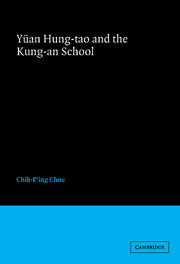Book contents
- Frontmatter
- Contents
- Preface
- 1 The literary scene before the rise of the Kung-an school
- 2 The literary theories of the three Yüan brothers
- 3 The poetry of Yüan Hung-tao
- 4 The prose of Yüan Hung-tao
- Epilogue: the legacy of the Kung-an school
- Notes
- The modern study of the three Yüan brothers and their Kung-an school: an introduction and select bibliography
- Chinese titles of works translated in chapters 3 and 4
- Glossary index
Epilogue: the legacy of the Kung-an school
Published online by Cambridge University Press: 30 October 2009
- Frontmatter
- Contents
- Preface
- 1 The literary scene before the rise of the Kung-an school
- 2 The literary theories of the three Yüan brothers
- 3 The poetry of Yüan Hung-tao
- 4 The prose of Yüan Hung-tao
- Epilogue: the legacy of the Kung-an school
- Notes
- The modern study of the three Yüan brothers and their Kung-an school: an introduction and select bibliography
- Chinese titles of works translated in chapters 3 and 4
- Glossary index
Summary
The active period of the Kung-an school lasted no more than fifteen years, from 1595 to 1610. In this short period, the expressive literary trend of the late Ming enjoyed a great vogue, and a writer's ability to express his innate sensibility (hsing-ling) was accorded the highest literary praise. However, this vogue did not last; Yuan Hung-tao's death in 1610 was a great setback for the expressive movement. After 1610 the opinions of the Kung-an school for the most part consisted of Yüan Chung-tao's compromised opinions and his somewhat reluctant criticism of his late brother, Hung-tao. Nevertheless, the influence of the Kung-an school not only outlived the death of Yuan Hung-tao, but also survived the decline of the Ming dynasty.
After 1610 the influence of the Kung-an school can be most immediately seen in the rise of the Ching-ling school {Ching-ling p'ai). The Ching-ling school has often been presented as the successor to the Kungan school. Chung Hsing (1574-1624) and T'an Yiian-ch'un (c. 1585- 1637), the founders of the Ching-ling school,1 have been regarded as followers of the three Yuan brothers. This connection can be deduced from the fact that the biographies of Chung Hsing and T'an Yuan-chun were appended to Yuan Hung-tao's biography in the Official History of the Ming (Ming-shih), instead of being entered as separate biographies.
- Type
- Chapter
- Information
- Yüan Hung-tao and the Kung-an School , pp. 113 - 122Publisher: Cambridge University PressPrint publication year: 1988

